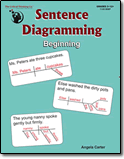Why do I love diagramming? I think because it is very orderly. Sentences are made up of specific parts of speech. Every part of speech has a particular place in the diagram picture, and when you diagram a sentence, you will always put the same words in the same space.
I also think that diagramming truly helps a student become a better writer. They become more aware of sentence structure, of having a balanced number of adjectives and adverbs rather than none at all or so many that a passage becomes unwieldy. I'm watching Matthew struggle with his writing, and I am thinking that he will soon be adding a sentence or two a day to his workload. Yes, at first a sentence can take several minutes to decode, but once you've had practice, it takes longer to find a ruler!
(And yes, I've turned into my mother. When I was in the fifth grade, our only written homework every night was math and one sentence to diagram. I can hear her voice: "Where is your ruler? A ruler. I said, FIND YOUR RULER.")
Sentence Diagramming: Beginning is a 72-page soft-sided workbook. It can be used as a consumable, but the publisher generously allows photocopying within a single family. As a parent of multiple students, I definitely appreciate this bit of potential frugality! The program begins with breaking down the simplest of sentences: a simple subject and a simple predicate, and adds a new part of the sentence/part of speech with each subsequent lesson. After finishing a second-grade level general grammar program, Jude knows subjects, predicates, objects, adjectives, adverbs, and conjunctions. This experience creates enough mix-and-match parts of speech for him to be able to start diagramming.
Each lesson contains several pages of practice, progressing from observing completed sentences to independently diagramming. Students are first asked to compare incorrectly diagrammed sentences with correct ones, then diagram sentences in a fill-in-the-blank scenario, and then given a sentence and basically told: "Have at it!"
We found the first few chapters quite easy. They focused on subject/verb, subject/verb/direct object, and sentences with adjectives. Jude did well grasping the concept of where things went but needed a little extra help with practicing. It is easy to hop from the workbook to a practice notebook and then back again.
Honestly, I think the hard part was trying to figure out sentences that fit the correct pattern. I would begin to write sentences, but have to go back and change things because I was naturally putting prepositional phrases -- i.e., "The cowboy rode in a rodeo," or wanting to continue "Annie ran," with a modifier like "quickly," that he hadn't yet learned. I loved that there is an appendix in the back of the workbook with the answers, but I would have really liked a maybe three or four-page section that had a list of sentences that went with each of the exercises. As you continue through the book, the sentences get more detailed, adding in conjunctions, prepositional phrases, etc. If you want to keep practicing the simpler sentences, you'll need to add in a notebook/outside worksheet program for supplementing. We are getting into the habit of creating and diagramming two or three sentences each day for practice. Here are our Election Day practice sentences:
Overall, I think this is a very clear way to introduce sentence diagramming. Jude was intimidated at first, but after a bit of practice, he remarked, "You know, this is kind of fun!"
Hey, Jude?
In addition to this workbook, the Crew reviewed a preschool academics software bundle, Reading, Writing, and Arithmetic Before Kindergarten!™ as well as the Language Smarts Level E program. Click the banner below to read reviews about each of these items.


©2012- 2016 Adventures with Jude. All rights reserved. All text, photographs, artwork, and other content may not be reproduced or transmitted in any form without the written consent of the author. http://adventureswithjude.com










No comments:
Post a Comment